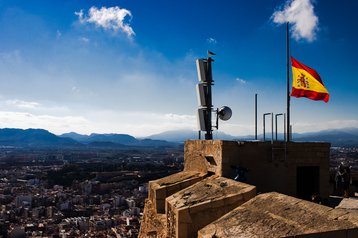Spain and Portugal this week suffered what has been called the worst blackout in the countries’ histories this week.
The sudden outage saw the equivalent of 60 percent of demand in Spain drop in five seconds around midday on Monday. Across the Iberian peninsula, factories and refineries shut down, trains halted, fridges warmed up, traffic lights and streetlights stopped working, and a state of emergency was called. Police and Red Cross workers handed out blankets and bottles of water.
While an investigation is ongoing, Spanish grid operator Red Electrica ruled out a cyberattack. It has suggested two incidents of power generation loss, possibly from solar plants, in Spain’s southwest that caused instability in the electric system and led to a breakdown of its interconnection with France, and had a cascading effect across the country.
According to Red Electrica data cited by Reuters, Solar photovoltaic (PV) accounted for 59 percent of Spain’s electricity at the time of the blackout, wind nearly 12 percent, nuclear almost 11 percent, and combined cycle gas turbine (CCGT) plants 5 percent.
However, in a span of just five minutes from 12:30pm local time on Monday, solar PV generation plunged by more than 50 percent to 8GW from more than 18GW. Power began to be restored by the early hours of April 28.
Spain was exporting power to France and Portugal at the time of the outage, leading to impacts on its neighbors. Portuguese grid operator E-Redes attributed the outage to “a problem with the European electricity system” and said it had to cut power in specific areas to stabilize the network.
Iberian Internet takes a tumble
According to Kentik’s aggregated traffic data, Internet service in these countries suffered a “massive” outage beginning at 10:34 UTC. Power and Internet services have largely been restored and are operating and close to normal again at time of writing.
An analysis by Cloudflare suggests Internet traffic in Portugal “immediately dropped by half” compared to the previous week as the power grid failed, falling to around 90 percent below the previous week within the next five hours.
“At a network level, the loss of Internet traffic from local providers including NOS, Vodafone, MEO, and NOWO was swift and significant,” the company said. Internet speeds dropped from an average of 40Mbps to 15Mbps, with latency more than doubling due to congestion on networks that remained live.
In Spain, Internet traffic dropped 60 percent compared to the previous week as the power grid failed, falling to approximately 80 percent below the previous week within the next five hours. Traffic from the top five ASNs in Spain fell between 75 and 93 percent in the hours after the power outage began. Internet speeds dropped from an average of 35Mbps to 19Mbps; latency also increased to 40ms, almost double its usual figure.
While power was impacted in Andorra and France – and reportedly caused issues as far as Belgium – Cloudflare noted no evident Internet traffic disruptions in these markets.
In Morocco, however, at least Orange Maroc was impacted: “Internet traffic has been disrupted following a massive power outage in Spain and Portugal, which is affecting international connections,” the company posted to X. Internet services via the telco were fully restored by the end of April 28. Cloudflare noted a major fall in traffic along the carrier’s network during the outage period.
Kentik also noted that Maroc Telecom and Telxius, the international arm of Telefonica, were also impacted. Edgoo Networks, a Portuguese provider that lists ZAP Angola as one of its customers, was also impacted.
Wireless operators, with a large footprint of cell towers across the region, turned to backup generation to keep their networks online.
During the power outage, Vodafone Spain posted that its network was “temporarily operating at 70 percent capacity.” In a post on X, the carrier said that it was operating at reduced capacity “thanks to backup generators, but its functionality will depend on the duration of the issue,” and said those with signal should use it responsibly, lest overuse collapse the service.
The telco said all its control centers, including its data centers, remained operational. By the afternoon of April 29, Vodafone said it had recovered 99.5 percent of mobile traffic. “Virtually all of our fiber and mobile customers can use their services normally,” it said.
MásOrange confirmed to Spanish publication El Confidencial that it was using gasoline-powered generators to keep power on in its offices. After recommended customers keep their phones in power-saving mode to limit communications, MásOrange said more than 90 percent of its network had recovered by the morning of April 29.
Telefónica also said its telecoms services were forced to rely on batteries and generators during the outage. By April 29, more than 95 percent of the work was back to normal, and is now fully operational.
“In the few locations where substantial power backup was available at mobile sites, either through batteries or stationary generators, site uptime was more resilient,” Ookla said in its own analysis of the events. “However, the cascading effects of increased load, driven both by users migrating from nearby offline sites and by subscribers relying on the mobile network as a substitute for fixed broadband, likely played a significant role in depressing mobile network performance.”
“The limited penetration of battery backup solutions in the mobile site grids across Spain and Portugal was a key contributor to the scale of network disruption caused by the collapse of the power grid on April 28, providing a historic lesson on the importance of infrastructure redundancy,” the monitoring firm added. “The policy success of Nordic countries such as Norway and Finland, where local regulators NKOM and Traficom have intervened with legislative instruments to stipulate a minimum number of hours of continuity of mobile service post-power outage, demonstrates that there are viable solutions to harden mobile network infrastructure. Similar efforts have been observed in Australia, where the government subsidized a ‘Mobile Network Hardening’ program to retrofit 467 cell sites with 12 hours power backup capability.”
How did the data center operators fare?
Spain currently has an estimated 156 operational data centers, with another 41 in Portugal. As well as local operators and international colocation companies, hyperscalers including Meta, Amazon, and Microsoft all have a footprint in Spain.
While any data center operator worth its salt will regularly test its backup operations, its not uncommon for issues to arise during real-world events. As the famous line from Mike Tyson goes; everyone has a plan until they get punched in the mouth.
Thankfully for the local industry, however, it seems the majority of the operators in the region survived the blackout unscathed.
Equinix noted to DCD Spain: “Equinix data centers in Spain and Portugal are fully operational and have been throughout the blackout. After the interruption of the electricity supply, emergency systems were activated to ensure service without interruption. With the restoration of supply, all our data centers in both Spain and Portugal operate normally.”
Likewise, Santiago Hernández Onís, managing director at Iron Mountain, told us all its systems worked without incident.
Start Campus, a new player in Sines, Portugal, said it was “fully stable throughout the period.”
Ivo Ivanov, CEO of Internet exchange DE-CIX, told us that its operations were not affected by the power outage.
“DE-CIX doesn’t own or operate data centers, but rents space in data centers operated by a range of different providers. We only choose data centers that have an uninterruptible power supply (UPS) composed of battery modules and emergency power generators. In this way, we ensure that our partners are 100% prepared for emergency situations, such as a blackout.”
The Barcelona Cable Landing Station noted that all cable and clients hosted at the CLS remained “fully operational and unaffected” by the power outage. Nabiax said there was “no loss of service” at its Spanish data centers, with all generators and backup systems coming into operation as planned. Posts from NTT staff likewise suggested the company’s MAD1 site in Madrid was able to switch from a grid connection to UPS and then backup generation without issue. Data4, which also operates a MAD1 campus in Madrid, said that its site was operational through the power cut with no impact to customers.
Francois Sterin, chief operating officer at Data4, said on LinkedIn: “The massive blackout in Spain and Portugal showed the importance of resiliency of digital and communications infrastructure. We can sometimes hear such events can’t happen … but they do. And we need to be prepared. We design and build our data centers for it, and our teams work every day to keep ready for it. Yesterday, our Spanish team got a little busy. Happy to report: ‘no impact’. Obviously not hoping for the next one, but humbly keeping ready as always.”
The Nixval data center, located in Valencia, reported that its operations were not affected by the blackout. According to the company’s CEO, José Luis Gómez-Pardo, “we are prepared for this type of contingency, and there was no impact on customers.”
He added that some customers, unable to communicate on a mobile phone, personally came down to the data center to verify the status of the services and check that everything was working.
Pedro Muñoz Olivares, director of operations at Global Switch, likewise noted a smooth transition to backup power during the incident. “We are very proud of how our infrastructure reacted,” he told DCD’s Spanish team.
Enrique Ramírez Muelas, regional operations director at Edged in Spain, noted its live facilities didn’t see any significant impact.
José Luis Herrero, CEO of local data center provider Walhalla, told DCD’s Spanish edition that coordination between authorities and electricity suppliers was “zero.”
Despite sending signals from orbit, Kentik’s data suggests that SpaceX’s satellite Internet service Starlink was also impacted in Spain from 16:11 UTC on April 28 to 04:21 UTC the following day.
“Starlink customers in Spain were, in fact, diverted to Starlink PoPs outside of Spain using non-Spanish IP addresses without the loss of service (assuming they could still power their dishes),” the company said.
While it’s too early to say what the impact of such a massive blackout will be on the region’s approach to grid management and renewable power, the data center industry might well want to give itself a pat on the back. It shouldn’t however, rest on its laurels.
“The recent power outages across the Iberian Peninsula are a stark reminder of how deeply interconnected our digital and physical infrastructures have become,” said Tony O’Sullivan, CEO of networking firm RETN: “The blackout disrupted telecoms far beyond Spain and Portugal, highlighting just how dependent even neighbouring countries and regions are on a few strategic routes.”
“Events like this reinforce why network resilience must be treated as critical infrastructure. Lessons must be learned from what has become a decade-long issue of poor network design worldwide. Operators must shift focus from short-term gains to long-term stability, ensuring infrastructure can support the continuity of essential services, even in the most unpredictable circumstances.”
DCD’s Spanish edition has written its own post-mortem of the Iberian power outage and its impact on local digital infrastructure, featuring many of the comments on which this piece is based. Read it here.
Thanks to DCD’s Alexandra Gheorghiu Tara, Daniel Fraga, and Ana Ribeiro for their assistance in this piece.
More in Critical Power



Episode
The big battery comparison
Read the orginal article: https://www.datacenterdynamics.com/en/analysis/how-did-iberian-operators-fair-in-the-great-power-cut/






